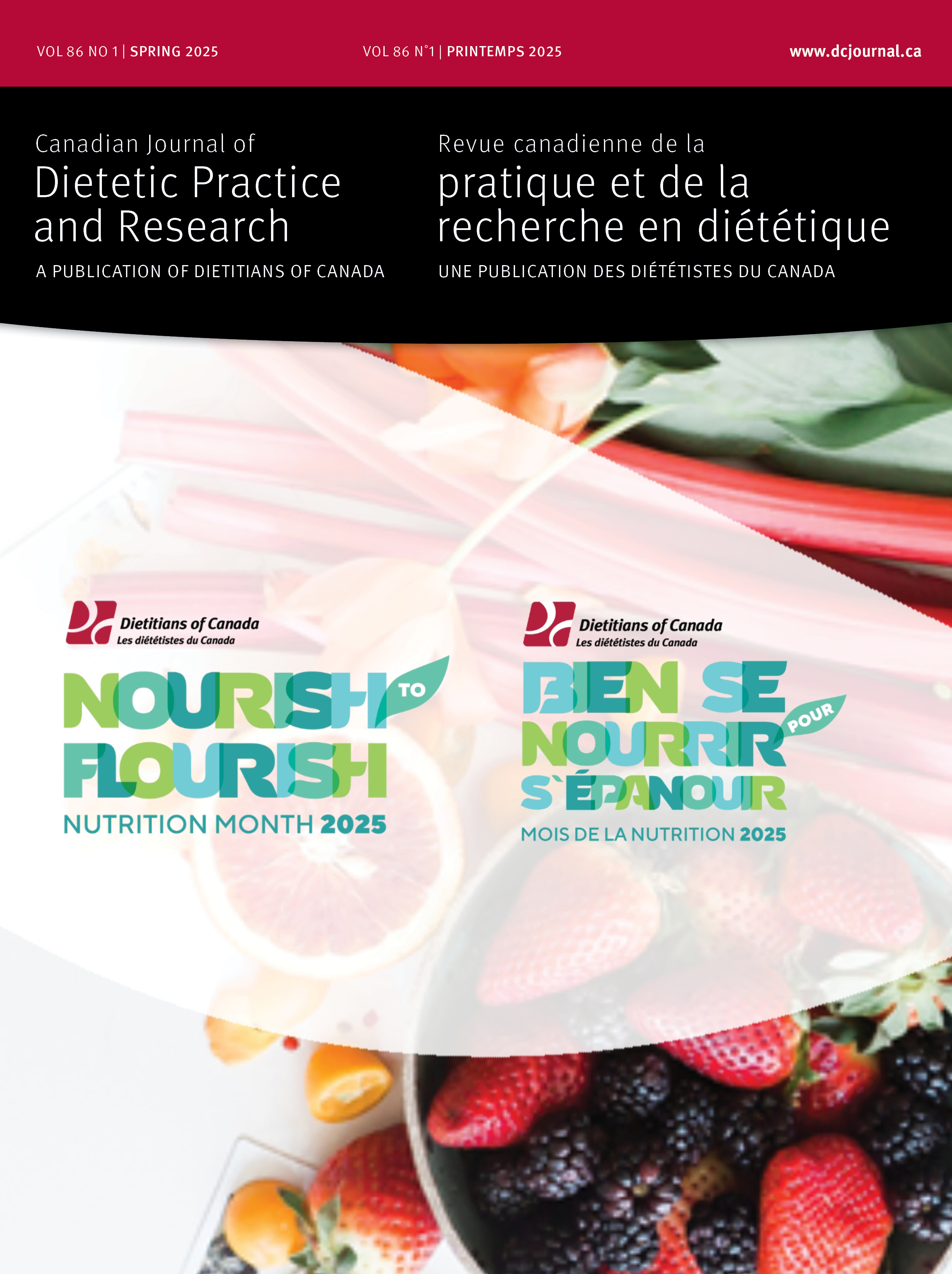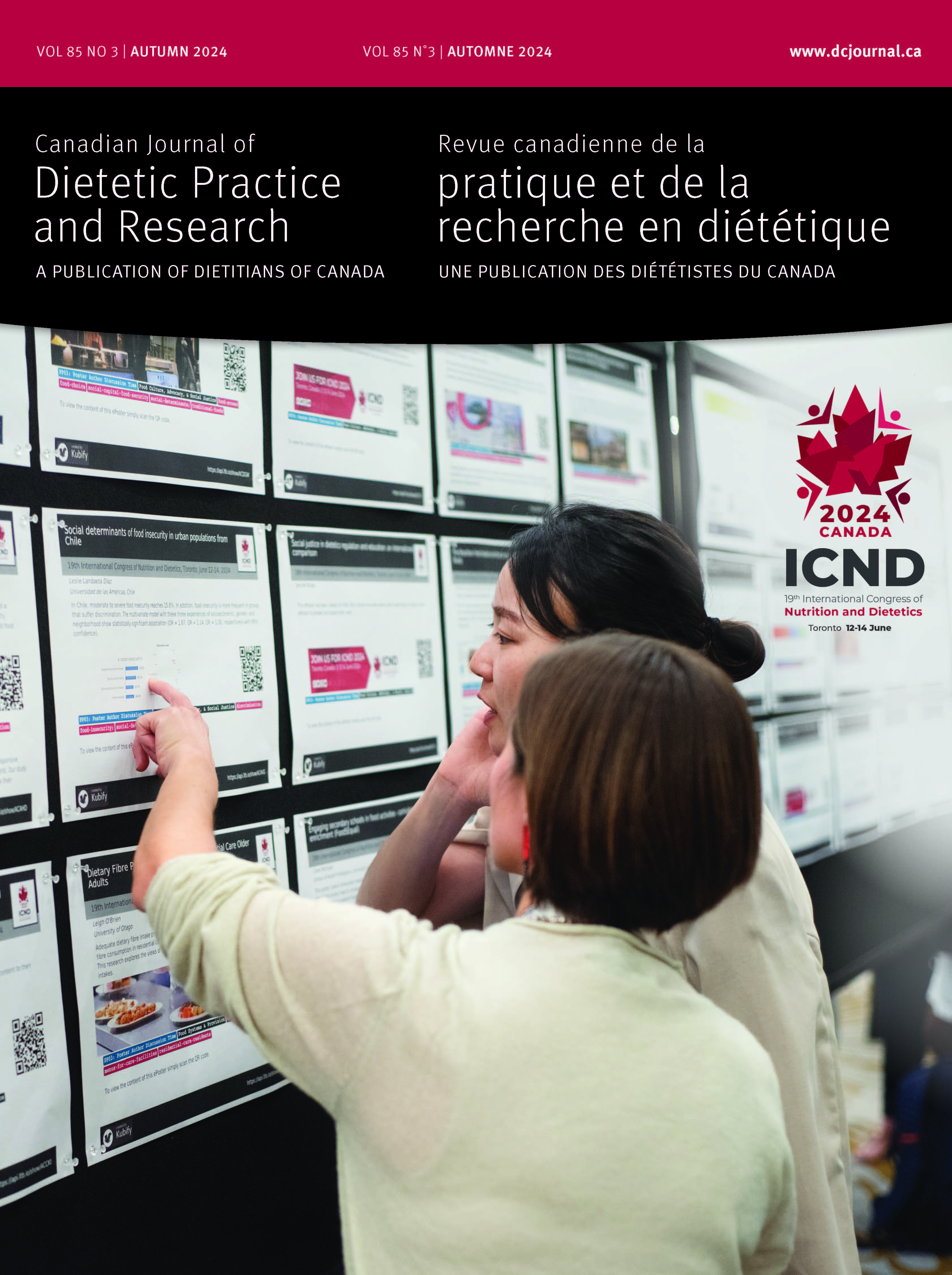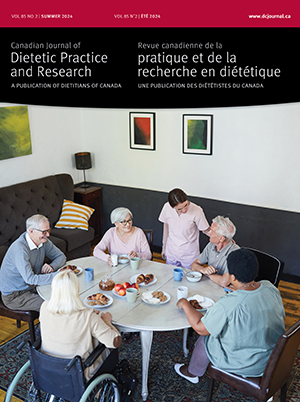Volume 82 • Number 1 • March 2021
Editor’s Message
Research
Purpose: To explore Canadian dietitians’ understandings of, attitudes towards, and engagement in socially just dietetic practice and advocacy.Methods: An online semi-qualitative survey sent to Canadian dietitians.Results: Respondents’ understanding of social justice and socially just dietetics practice highlights the unique ways that social injustice and health inequities may be addressed by dietitians. Overall, respondents had a positive attitude toward dietitians’ roles in social justice advocacy. Support for dietitians’ advocacy roles was highest for food-related concerns, but it declined for concerns with indirect connections to dietitians’ food and nutrition expertise (e.g., environment). However, respondents still had uncertainty and divided perspectives concerning if and how social justice fits within dietitians’ scope of practice. They also had concerns about barriers that they felt limit dietitians’ ability to perform socially just practice. Respondents shared efforts to engage in socially just practice at intrapersonal, interpersonal, and structural levels.Conclusions: Dietitians could be a critical influence on the determinants of health. This research points strongly to the need for a framework for socially just dietetic practice and advocacy that delineates what social justice looks like across the array of settings in which dietitians practice and within the array of fora that dietitians advocate to support nutrition and health.
Perspectives in Practice
Participants at the second National Gathering of the Aboriginal Nutrition Network (ANN) were encouraged to submit their favourite traditional recipes. Approximately 40 were received, and a volunteer working group contacted contributors to assist in the creation of a recipe resource with a selection of 12 recipes that included traditional ingredients to promote Indigenous foodways. All contributors were interviewed to share stories about their recipes. Each recipe was then tested, photographed, and developed into a resource handout that was disseminated to a variety of stakeholders. Afterwards, a brief survey was conducted with ANN recipients of the recipes (n = 23) to evaluate the recipe collection. When asked, “Prior to learning about this resource, was a collection of recipes using traditional foods something that you or the communities you work with were interested in?” all respondents answered yes. Nearly all found the recipes easy to follow (91%), and that they were applicable to the interests or needs of the communities they work with (83%). Preserving recipes and building opportunities for dietitians and other health professionals to contribute to traditional food recipe collections facilitates increased knowledge transfer, enhanced cross-cultural understanding, and is generally a useful tool for those working with Indigenous Peoples in Canada.
This paper investigated how traditional media headlines framed the release of Canada’s Food Guide (CFG) online in 2019 and how audiences reacted to its release on social media. Titles of online news articles, Facebook comments on news stories, and tweets from Twitter were collected using Meltwater and manual data collection. Leximancer software conducted conceptual extraction and relational analyses on written words and visual text. Human coding was completed to contextualize the content, which identified 9 prominent frames (food guide, impact, health, sustainable plant food, who will use?, Canadian culture, food and consumption practices, meat, and dairy). Results suggested that online news headlines highlighted CFG release and alluded to potential impacts. Analysis of Facebook comments revealed that the most commonly discussed frames were health, food and consumption behaviours, sustainable plant food, and meat, while the majority of the tweets were in direct reference to CFG being released, oftentimes with a link to another webpage, and discussed the intersect between health and food and consumption practices. In conclusion, the analysis revealed how frames emerged from social media users that shifted the discussion away from CFG release and impact to the influence of health and food and a plant versus meat debate.
To determine the food sources of energy and 13 core nutrients, 89 diet recalls were analyzed from an explanatory mixed-methods pilot study with adults following a gluten-free diet (GFD) for any reason. Nonconsecutive dietary recalls were collected through a web-based, Automated Self-Administered 24-Hour (ASA24®—Canada-2016) Tool. Mean nutrient intakes were compared with Dietary Reference Intakes. Food items (excluding supplements) were extracted and categorized according to the Bureau of Nutritional Sciences Food Group Codes. Percentages of total dietary intakes from food sources were ranked. Grain products were the highest ranked contributor of energy (21.4%), carbohydrate (30.3%), fibre (29.1%), and iron (35.3%). Breakfast cereals, hot cereals, yeast breads, and mixed grain dishes (mainly rice or pasta-based) were the most important nutrient contributors for grains, despite most (64.3%) commercial cereals and breads being unenriched. Legumes and seeds were not frequently consumed. Nutrient density in the GFD could be improved with more emphasis on gluten-free (GF) whole grains, legumes, seeds, and enriched breads and cereals. More research is needed on the nutrient composition of GF foods to identify food sources of folate, other B vitamins, zinc and magnesium—nutrients of concern for those requiring a GFD.
Nutrition is important for prostate cancer (PCa) care as it may influence PCa progression and risk of comorbid diseases. The aim of this pilot study was to assess changes in knowledge and satisfaction in men with PCa following attendance at a nutrition education seminar. Fifty-two men with PCa attended nutrition education seminars instructed by a Registered Dietitian. Participants completed the Revised General Nutrition Knowledge Questionnaire (GNKQ-R) preseminar and 2 weeks postseminar, along with a satisfaction survey. Increased nutrition knowledge was observed through a significant (P = 0.023) improvement in mean scores of 71.6% (P < 0.005) preseminar compared with 79.3% (P < 0.005) postseminar on the GNKQ-R. Participants reported the seminar as a satisfactory method for meeting their diet information needs. Using thematic analysis 3 themes emerged: importance of diet information, desire for an integrative approach, and the value of group learning. This pilot study found that a group nutrition education seminar may be an effective and satisfactory approach to fulfilling the dietary information needs of this population. Group education may be an economically sustainable approach with potential application in other tumour sites or health conditions.
The purpose of this study was to determine if staff perceive a mealtime management video to be a beneficial and useful training tool in long-term care (LTC) homes. An email invitation was sent to the Dietitians of Canada Gerontology Network inviting dietitians working in LTC homes to participate. A previously used and reliable 25-item questionnaire was used to assess sustained attention/mental effort, learner satisfaction, clinical experience/relevance, and information processing of the video. Dietitians were asked to show the video to LTC staff and distribute the questionnaire to staff after viewing the video. A total of 769 surveys were completed at 28 LTC homes across Canada. Eighty-seven percent (n = 637/736) of participants felt more knowledgeable after viewing the video and 91% (n = 669/738) found the video format easy for learning. Managers had a higher Likert scores (mean = 6.2 out of 7) than continuing care assistant (mean = 5.7, P = 0.02) and food service workers (mean = 5.5, P = 0.001) for the clinical relevance scales. No differences were found for age (χ2 = 5.52, P = 0.60), gender (χ2 = 2.65, P = 0.10), and size of home (χ2 = 3.34, P = 0.34). Staff perceived the video to be useful for their work with residents living in LTC homes and it raised awareness of the importance of their roles at mealtimes.
Report
Introduction: Treatment of celiac disease is a strict life-long gluten-free diet (GFD). The GFD is complex, and counseling by a dietitian is essential. The number of new referrals for GFD education has increased. We studied the feasibility of GFD teaching using distributed education.Methods: The IWK Health Center in Halifax is the only tertiary-care pediatric hospital in the 3 Maritime provinces with GFD experienced dietitians. Families travel long distances to attend teaching sessions. Families outside the Halifax area were offered to participate in the 2.5-hour education sessions held once a month via live videoconference link at their regional hospitals. All participants were surveyed with a 10-item questionnaire assessing the content and delivery and usefulness of information.Results: Over a 6-month period, 39 families attended the sessions, 21 locally and 18 at distributed sites across the Maritimes. The survey was completed by 26 participants (67%). All participants at both sites strongly agreed or agreed that their setting was good for learning and the information provided was easy to understand. There were no significant differences between the 2 groups on any individual questions in the 2 domains assessed (all P > 0.06).Conclusions: Distributed education on GFD is feasible and as effective as in person education. It affords convenience and savings to families by reducing travel costs.
Purpose: To pilot test the Food Skills Questionnaire (FSQ) to evaluate a cooking intervention.Methods: Students attending Western University were invited to participate in 3 cooking classes over a 3-month period. All participants were asked to complete the FSQ pre- and post-intervention. The FSQ evaluated food skills in 3 domains—Food Selection and Planning, Food Preparation, and Food Safety and Storage—with a maximum score of 100 per domain. Domain scores were then computed as a weighted average for the Total Food Skills Score out of 100. Open-ended questions assessed participants’ perceptions of the classes.Results: Forty-four students participated. There was a significant increase in food planning (70.6 ± 13.5–77.6 ± 14.3, P < 0.01), food preparation (67.5 ± 14.0–74.9 ± 12.9, P < 0.01), food safety (78.0 ± 9.9–80.8 ± 13.0, P = 0.04), and total food skills (71.9 ± 8.9–77.8 ± 10.6, P < 0.01) post-intervention. Content analysis of open-ended questions indicated that participants enjoyed healthy recipes, supportive Peer Educators, discussions, the cooking experience, socializing, and the safe environment.Conclusions: The FSQ shows strong potential for evaluating basic (e.g., peeling, chopping, slicing) to intermediate (e.g., meal planning) food skills in an effective and feasible manner. It can also capture changes in specific domains, allowing the development of more focused nutrition education and skills-based interventions.
Purpose: To explore knowledge, attitudes, and behaviour related to physical activity (PA) and sedentariness among registered dietitians (RDs) in family health teams in Ontario.Methods: This cross-sectional, descriptive study utilized a semi-structured interview guide to conduct qualitative interviews with 20 RDs. Self-administered questionnaires were used to assess personal PA (short version of the International Physical Activity Questionnaire) and sedentary behaviour (Sedentary Behavior Questionnaire).Results: Thematic analysis indicated that, in general, participants had good knowledge of PA and sedentariness. They were knowledgeable about the PA guidelines. They had positive attitudes toward PA and nonsedentariness, stating that both are important in the prevention and treatment of chronic conditions. Quantitative analysis indicated they had moderate-to-high PA levels and were fairly sedentary.Conclusions: This study supports the position that RDs can serve as excellent role models for PA. Though participants had basic knowledge, RDs may benefit from additional education regarding PA and sedentariness when counselling.










